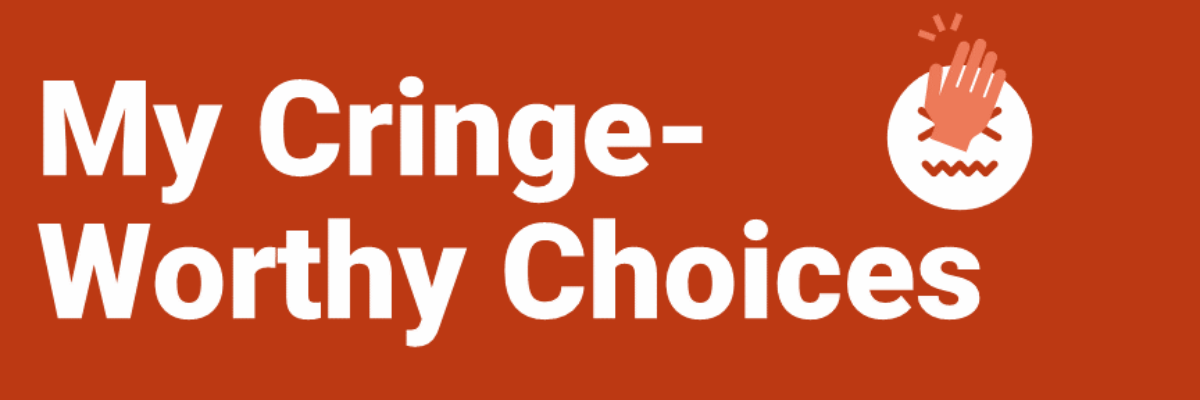The theme of this blog post can be summed up with one emoji: >.<
If you aren’t emoji-fluent, that’s the facepalm, a gesture made when you are internally dying of embarrassment over someone’s incompetence. In this case, that someone is me. I have failed to recognize when I was using phrasing and framing that was inappropriate and offensive. I didn’t see it at the time – thought I was just being cheeky. In hindsight, >.<
So, shall we walk through some of my more cringe-worthy mistakes?
My Ableist Language
When you are an author, growing is a humbling experience because your thoughts are IN PRINT. In the first AND second edition of one of my books, I referred to something as “schizophrenic.”
Readers sent emails to me and my editors, linking us to the National Alliance on Mental Illness, which advises that mental disorders not be used as adjectives. Yep! And >.<
Mental disorders have not historically been on my radar, largely because I’ve been privileged enough to not have to experience them personally. This has also caused me to review how often I’ve used “crazy” or “bananas” or something similar to discuss a particularly busy chart and how I surely don’t need to be causing anyone who does have a mental disorder to bear any further stress by my thoughtlessness. Here are alternatives to consider. SAGE says they are replacing the word in the next printing of the book.
I didn’t realize how ableist I was until I started hosting people with total blindness in my workshops. The advice I got was “just explain, out loud, everything that you are showing on the screen” which, to be honest, was simply not practical for a data visualization workshop. I don’t have all of the solutions to this one sorted out but I can tell you that I have since become extremely aware of how often I say things like “Notice how in this graph…” and “See how in this graph…?” and “Look at this thing in this graph…” ?
My Violent Language
I listened to this beautiful conversation between Ocean Vuong and Krista Tippet, on the On Being podcast, where Ocean talks about how violence is baked into our language. Being successful is often phrased as “slaying it” or “killing it” and that Ocean had become uncomfortable using those words. That resonated with me so hard.
In my workshops I often talk about how if we avoid the use of the red/green color combination, we both handle colorblindness AND the reprinting in black-and-white issue. A couple years ago, I switched from describing this double solution by saying “we can kill two birds with one stone” because it felt meaner than I wanted. Now I say “feed two birds with the same seed.” Sometimes it takes me saying my words in front of big groups to really hear myself. >.<
PETA got crap for it, but they suggest a bunch of alternatives to some of our violent phrases (and they used red/green >.<):
Whether you agree with PETA or not, their suggested alternatives are more creative and peaceful.
My Culturally Insensitive Language
One more >.< example for now. In my Data Visualization Academy, we rate each graph tutorial on a scale that tells you how much effort will be required. When The Evergreen Data Certification Program students learn 50 tutorials in a year, we customize their curriculum to span this scale. Up to this point, I referred to this scale as a “Ninja Level.” I also use this reference in my books and workshops:
I thought it was cute at the start. The Evergreen Data Certification Program students referred to themselves as ninjas and I even saw someone who dressed up as an Excel Ninja for Halloween. But I saw some criticism that Tableau’s use of “Zen Master” to describe the people they train is appropriative. I agreed. And that made me reflect on my use of Ninja. It isn’t really different.
So we’ve swapped our tutorials inside the Academy. We now assign them Rockstar Levels:
And I’ll be switching to this language in my workshops and book (if/when I write another edition).
I know some of you are thinking “Where are the limits of this political correctness?” “What about when ‘Rockstar’ becomes cultural appropriation?” And that, friends, is how you board the slippery slope. Don’t get on. If people are telling you (or – better yet – if you are sensing) that you are using phrasing that is offensive, just change it. Don’t spiral into “what’s next OMG pretty soon you’ll be able to marry your dog!” DO think about how coming from a place of privilege often muddles us and that getting feedback from others is a gift. The act of being open to other people’s lived experience is what makes this so much more than just a swap of phrases.
Maybe one day Rockstar WILL be culturally inappropriate. If that day comes, I’ll keep evolving. Becoming more inclusive is an ongoing process. For everyone. Take counsel from Angelou: “I did then what I knew how to do. Now that I know better, I do better.”





